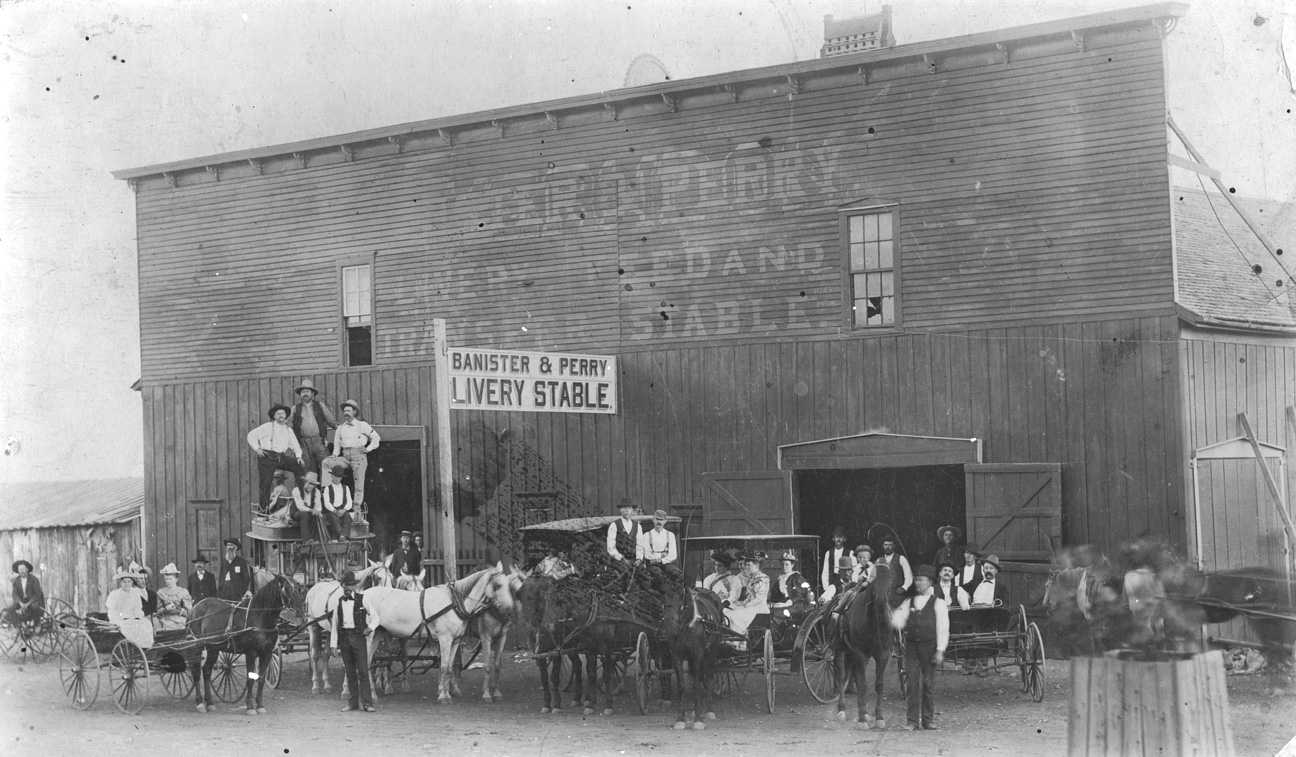| As this northeast quarter of Block
8 of the Original
Townsite of Coleman was originally one business and what
is now 108
East Pecan Street, 110
East Pecan Street,
112
East Pecan Street and 114 East Pecan
Street were built as one building, it is
difficult, at times, to separate
the building into separate addresses, as it is now, in
2005. What
is now 110 East Pecan Street is legally known as the
east half of lot 12
of Block 8 of the Original Townsite of Coleman.
| In 1888, F. W. Dudley’s
Livery Stable was located
in the half block bounded by East Pecan
Street, South Colorado Street,
East College Avenue and the alley to the
west. The north part of
the livery stable was two stories tall, with
the south side of the barn
and the office on the east side being one
story. There was a shed
on the southeast corner of the lot.
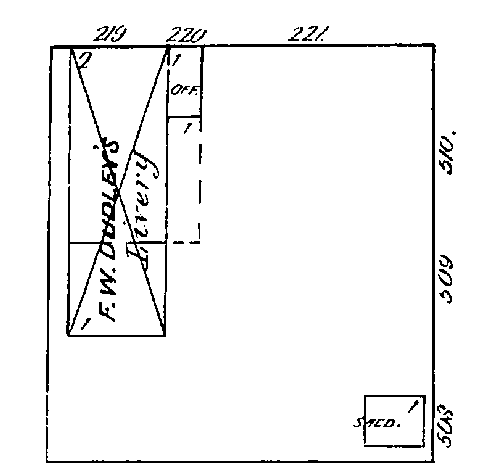
south
side - 1888 map
|
By 1893, the livery
stable had changed hands
and was called the Banister and Perry Livery
Stable. The east side
addition had been removed and an additional
two story barn had been added
to the east side. A water tower had been
added to the south side,
and a open shed replaceing the older shed on
the southeast corner.
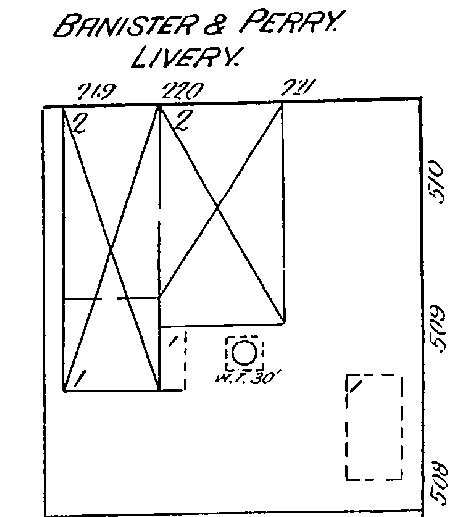
south
side - 1893 map
|
Leona Bruce Collection
- copies available at terrystudio.net
Banister and Perry Livery
Stable - 1892
John R. Banister standing in front of the white horses,
pulling the
stagecoach, to the left. The other owner, W. C.
Perry, has not
been identified.
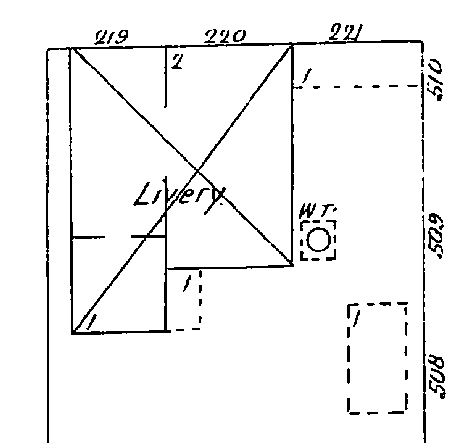
south
side - 1898 map
|
By 1898, the stable was
under one roof and an
open shed added to the northwest corner.
The water tower had been
moved northwest.
By 1904, these building
had been removed, probably
in preparation for the building of the brick
building.
|
| By 1905, a new one story
brick building had been
built at what is now 108, 110, 112 and 114
East Pecan Street by Louis Litt.
The building had cement floors and skylights
over the 3 westmost businesses.
L. Litt Dry Goods
Company occupied what would
become 112 and 114 East Pecan Street,
dealing in dry goods and notions
and clothing, hats and shoes. These
buildings were connected by a
door between the two buildings.
For a short time, about
1906, the Farmers State
Bank was located at 110 East Pecan Street.
There was an inside
door connecting 108 and 110
East Pecan Street, which was occupied by
Sewell Furniture and Hardware
Store, which became Sewell and Fox by 1911.
Note on this 1909 map,
what would become 108 East
Pecan Street is shown as 219, 110 East Pecan
is shown as A, 112 East Pecan
is shown as 220, and 114 East Pecan is shown
as 221. The 2 eastmost
businesses were located on lot 11 and the 2
westmost were located on lot
12.
|
 south
side - 1909 map
south
side - 1909 map
|
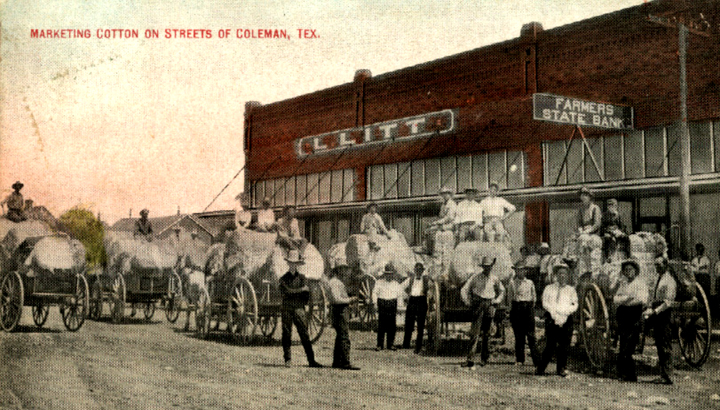
early
Coleman postcard
"Marketing Cotton on
Streets of Coleman,
Texas"
L. Litt Dry Goods Company at 112
and 114 East
Pecan Street, Farmers State Bank at 110 East Pecan
Street.
One story brick building built by
Louis Litt
about 1905.
north
side - about 1908
A note about Louis Litt:
Louis Litt was an early developer of Coleman, who
was here only about 15
years, but apparently was a successful businessman,
primarily in dry goods,
and was involved in community affairs. He had
arrived in Coleman
by 1897, and bought and sold a number of properties
in Coleman, according
the Coleman County deed records. He and his
family lived at what
would become 403
West
College Avenue.
According to the 1900 census,
he was born in
New York in November 1861 of French parents.
He married Mamye M.
(her maiden name was Mayer - see the following
obituary for her father),
born in West Virginia about 1862, with her father
being born in Germany
and her mother in West Virginia. Mayme worked
as a saleslady in their
dry goods store. Louis and Mayme married about
1889, and had one
son, Henry M. Litt, who was born in September 1890
in Texas. Living
with them in 1900 was Duncan McGregor, who was born
in October 1860 in
Canada, of Scottish parents. He appears to be
working for the Litts
as a salesman.
After building the brick
building on East Pecan
Street, the Litts appear to be less involved in
sales, but more in buying
of goods. On February 4, 1910, an
advertisement for The Litt Dry
Goods Company, B. A. Pessels, Mgr. stated:
“Mr. L. Litt will be resident
New York buyer for this house, he will keep new and
fresh goods coming
all the time, an advantage no other store in the
city has. …”
Then the Litt's 18 year old
son Henry
Litt, who had been ill with Typhid Fever since
at least early February,
died on February 20, 1910, and his body taken to New
York for burial.
Apparently Louis Litt and his wife left Texas and
did not return to live
in Texas after this time, but remained in New York,
his native state.
The 1910 census, taken May 13,
1910, finds
Louis and Mayme Litt in Manhattan, New York, as
guests at the Hotel Lucerne.
Louis is shown as a buyer of dry goods, working on
his own account.
In 1920, he and his wife are
still in New York,
living on Riverside Drive, and Louis is working as a
stock, cotton and
grain broker.
On the 1930 census, taken
April 24, 1930, Lewis
Litt is shown living on West 73rd Street, New York
City, New York, a renter
in a large apartment building, head of his
household, age 68, married at
age 27, born in New York, with his parents born in
France. He is
working as a salesman as (or for) a broker.
Louis is not shown as
a widower, but as Mamye Mayer Litt is not shown with
him, it appears that
she is deceased by this time.
Daniel Mayer
Charleston Gazette
- May 22, 1910
--------------------------------------------------------------------------------
The remains of Dr. D.
Mayer were brought to Charleston last
evening from Cincinnati, the city
in which he died. The funeral will
be held Monday at 2 o'clock p.
m., from the residence, 138 Summers
Street and will be conducted by Rabbi
Leon Volmer, of the Virginia Street
temple. Before he left here for
Cincinnati and while realizing the
possibility of his dying while away,
Dr. Mayer asked that he be buried while
wearing a suit indicating his membership
in the G. A. R. And before he left he
named four of the men he wished to
be his pass bearers. These were
Col. W. E. Chilton, ex-Governor W.
A. MacCorkle, M. Goldbarth and Charles
Loeb. After he had named these
men, who were his friends for many
years, he grew too weak to name the
other two, but it was suggested that he
intended to name Hon. Adam Littlepage
and Ike Lowenstein, and they have been
designated as the other pall bearers.
Throughout the city of
Charleston expressions of regret were
made when it was learned that Dr.
Mayer had died. Nearly everyone
who has been here for any length
of time knew him and every one who had
the honor of his acquaintance liked
him. He was for many years
identified with business, professional
and political affairs, and was
successful in nearly all of his
undertakings.
In fact he was one who might have been
termed properly a self-made man.
At the time of his death he was aged 73
years, four months and fourteen
days, having been born January 6, 1837,
in Nierstine, Germany. He
is survived by ten children, who
are: Dr. Joe Mayer, Winfield;
Albert
Mayer, Ballard, West Virginia; Edgar
Mayer, Decorah, Iowa; Ernest Mayer,
Boston; Dan Mayer, Hinton; Ralph Mayer,
Hinton, Bernard Mayer, Tampa, Fla.;
Mrs. Charles Winkler, New York; Mrs. Lewis Litt,
New York, and Mrs. James Fahy,
New York. Mrs.
Litt
was formerly of Texas. She went
to New York three months ago
to bury her son who had died in the
southwest, and will make her home
there.
Dr. Mayer is given credit
with being the founder of Odd Fellowship
in South America. He was
distinguished in that order as he was in
the Masons. In fact he was
one of the few thirty-third degree
Masons in this state, having obtained
to that exceptional rank through
services rendered the
organization.
He measured high in the rank of success
in every line he undertook, and
from, 1853, when he came to this
country, he met with few reverses.
Before coming to this part of the
country after landing in New York from
Germany, Dr. Mayer spent one year in New
York, and then went to Pomeroy,
Ohio, where he remained several
years. He was identified with the
salt industry in Meiggs [sic] County for
some time and then went to medical
college in Cincinnati where he
graduated. Later he went back to
Pomeroy
where he practiced his profession and
edited the Granraus, a German
newspaper, for a few years. When
the Civil war was called, Dr. Mayer
formed a company of volunteers in
Jackson county, and the company was in
camp in Mason county for some
time. Dr. Mayer was elected
captain
but soon afterwards resigned to accept
the position of surgeon in the Fifth
regiment of West Virginia
volunteers. He served in that
capacity
till September 1864, when he was
honorably discharged. At the time
of his death he was commander of the
department of West Virginia G. A.
R., and was held in high regard by all
the veterans. His last ambition
was to be present at the encampment
which was held here last week and he
had prepared an able address to be
delivered then. During the moments
of his delirium just before his death he
made reference to the speech and
called the names of a number of comrades
who were near and dear to him.
The successful career
of Dr. Mayer shows what pluck,
perseverence [sic] and talent will
produce.
He was interested in the insurance
business for a number of years and made
a success of that just the same as he
did while practicing medicine and
following the profession of law.
In politics he was a leader and
was one of the most notable characters
while in the legislature of the
state during two terms. Then when
he went as consul to Buenos Ayres
he made such a record that he was
appointed later, by President Roosevelt,
as consul general there, a post he
occupied with distinction for four
years.
It was during one of his return trips on
a vacation, that Mrs. Mayer died
on board ship and was buried at
sea. That deplored occurrence was
April 15th, 1905. Three years ago
Dr. Mayer married Miss Olive Blumback,
of Newport, Kentucky, who survives
him. No children were born to
their union.
West
Virginia Archives and History -
(http://www.wvculture.org/HISTORY/government/mayerdaniel02.html)
|
| Sometime after 1910, the
building was purchased
by Dr. O. B. Manes and was called the Manes
Building.
Between 1911 and 1916,
the second story was added
by Dr. Manes to the four brick buildings of
what is now 108, 110, 112 and
114 East Pecan Street. There were
inside doors, on the second floor,
connecting 108 and 110, and 112 and 114, but
no indication that 110 and
112 were connected. In addition to the
second floor, there were balconies
in three of the four businesses, creating a
partial floor between the first
and second floors. Club Rooms were
located on the second floor of
the two eastmost businesses.
108 and 110 East Pecan
Street were still connected
by an inside door and together these two
stores were known as the O. B.
Manes Hardware Store. The first floor
of 110 East Pecan Street was
occupied by the “Variety Store,” and 108
East Pecan Street by “Furniture
and Hardware.” There was a 270 gallon
gasoline tank located underground
in front of what is now 108 East Pecan
Street.
Note these addresses
were then called 112, 114,
116 and 118, with alternate (or previous)
addresses as in 1909.
|
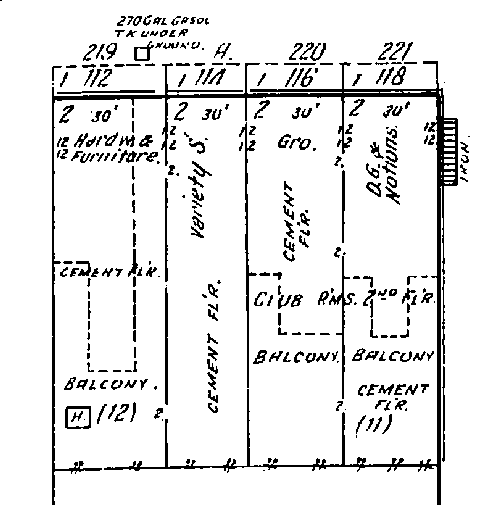
south
side - 1916 map
|
In October 1916, the O. B. Manes
Hardware Store
was purchased by J. F. Gordon.
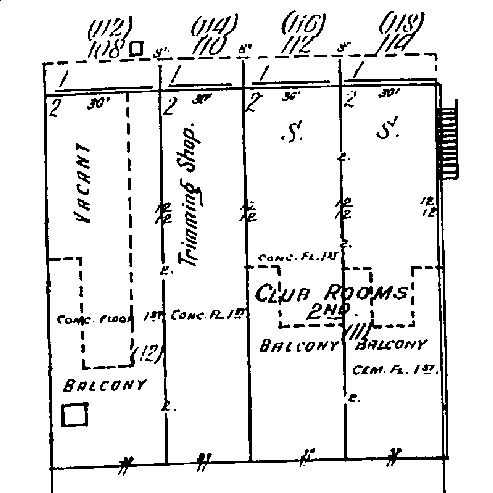 |
By 1923, 108 East Pecan
Street was vacant, and
110 East Pecan Street was occupied by a
“Trimming Shop,” but I am not sure
what this was. |
"In
1929, Central City
Hotel was located at 110 1/2 East Pecan
Street. The proprietor
was Mrs. S. A. Smyth. Their motto was "In
Heart of the City" and
"Hospitality is Our Motto." Their telephone
number was 41, and their
location was one half block east of Commercial
Avenue. Rooming at
the Central City Hotel was James T. Mills, a
painter at Coleman Body
Works." (Coleman
City Directory, 1929 -
Hudspeth.) (Note:
The second story
of 110 East Pecan Street was 110 1/2 East Pecan
Street.)
In 1929, 110 East Pecan was shown
as vacant, but
it appears the 110 served as a lobby for the Central
City Hotel which was
located on the second story of the quarter-block,
their address being 110
½
East Pecan Street.
By 1930, the entire second floor
over the four
business was occupied by the Central City Hotel.
By 1948, the Central City Hotel
had apparently
closed over the four buildings. There is no
indication what occupied
110 East Pecan Street, but the second story over the
four building indicates
“Rooms,” so rooms were probably still being rented on
the second story
of these four buildings.
|
